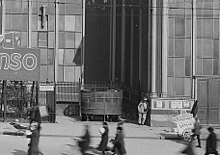Pee curl
The pee curl (Dutch: plaskrul) is a urinal that is placed in multiple different locations in center of Amsterdam as public toilet. The design was made in the end of the 19th century from the Dienst der Publieke Werken.
The curl is made of a spiral-shaped iron plate that carried half a meter above the ground by four iron legs. The top half of the plate is perforated so that you can see through at eye-level. The urinal sheet-iron is painted dark green. The floor is made of tiles with a natural stone slab in an upright position and a urine gutter. The curls are connected to the sewer and are cleaned by the local municipality with water from the canal. The curls in a single or double version and some curls are equipped with a roof.
History

In 1859 inventor Leijs proposed to place hollow pillars. However the design of the curl was chosen. The key element was transparency. It was easier for officers on duty to determine if there were multiple people in the urinal; because in the 19th and most of the 20th century such facilities were used by homosexual men to have sexual intercourse.[1] In 1980 around 40 curls were used for sexual intercourse, but at the end of the 1990's this practice was as good as gone.[2]
The first curls where placed around 1870. The first double curl was placed in 1877 at the Paleis voor Volksvlijt. [3] In 1916 a new design was made by the architect Jan van der Mey.[4] The ornamentation at the top was removed and the urinal was provided with a half-cylindrical cap.
In 1928 the urinalcommission was founded.[5] They decided the locations of the curls and moved on with building the public urinals via the Kiosk Organisation of Amsterdam. This included a telephone, water tap and a toilet. These facilities were closed after some time because of the high costs.
In 2008 all peecurls were galvinsed and restored.[6] The city had thirty-five peecurls in 2017.[7] From those are two made by the "van der Meymodel". The peecurls to the side of the canals are kept in place by the local government to keep people from public urinating and thereby falling in the canal. Because of multiple causes, on average 15 people drown each year in the canal.[8]
Pee-right
The urinals are focused on men. This comes from the reasoning of the urinalcommission that the urinals are intended for 'the man who has his job on the street'. In addition the costs for completely closed toilets are higher and could be used for lewd conduct. These were the reasons to propose to close most of these facilities in the 60's. This led from the function as meeting point to a protest from the gaymovement.[9]
On January the 24th 1970, Dolle Mina took action to close the peecurls with pink ribbons to demand 'peeright'.[10] In 1985 the urinalcommission gave positive advice to place automatic public toilets, but just in that time the commission was shut down and this plan was cancelled.
The man-focused design came to the spotlights in 2017 because a woman in Amsterdam was ticketed for public urinating. The offender did not use the peecurl because of the possibility of cleavage while crouching. She refused to pay the fine because of discrimination against woman. According to the judge, the peecurls are suitable for woman and she was forced to pay the fine.[11] This led to the national urinalpeeaction Zeikwijf that got international attention.[12][13]Amsterdam knew in 2017 besides the urinals in total three public toilets that are suited for woman. This is lower than in comparable cities. In 2017 Berlin had 177 public toilets and Paris 150 public toilets.[14]
New urinals
The government of Amsterdam places temorary urinals (Dutch: plaskruizen) and urinals that can be retracted underground particularly for the nightlife public. In 2016 such a retractable urinal was placed at Paleis op de Dam that had two men urinals and one for women.[15]
.jpg) Map of a curl.
Map of a curl. Double curl with a roof
Double curl with a roof_aan_de_Reguliersgracht%2C_Bestanddeelnr_927-3068.jpg) Older version
Older version- Lowered curl in Oosterpark
 Detail of the natural stone, Brouwersgracht.
Detail of the natural stone, Brouwersgracht.- Museum Het Schip with one Van der Meykrul
References
- Krul, Amsterdamse School
- Jos Versteegen, Roze Amsterdam, Een culturele gids, Bloemendaal 1998, p. 244-245.
- De verwaterde stad, De Groene Amsterdammer, 18 februari 1998
- De verwaterde stad, De Groene Amsterdammer, 18 februari 1998
- https://archief.amsterdam/inventarissen/overzicht/5413.nl.html
- De krullen van Amsterdam, D. Cornelissen & Zonen, 2008
- Locaties Plaskrullen Stadsdeel Centrum, gemeente Amsterdam, geraadpleegd maart 2018
- Te veel mensen verdrinken in de Amsterdamse grachten, NRC, 25 maart 2017
- 5413: Archief van de Gemeentelijke Urinoircommissie en de Commissie Straatmeubilair, Stadsarchief Amsterdam
- Openbaar plasrecht voor vrouwen, Atria, 21 september 2017
- Toch wildplasboete: 'Vrouwen kunnen ook in urinoir plassen', Parool, 18 september 2017
- Een vrouw in een plaskrul? ‘Geen goed idee’, NRC, 23 september 2017
- Protests planned at Amsterdam urinals over lack of women's toilets, The Guardian, 21 september 2017
- Zijn we echt het pispaaltje op openbaar toiletgebied?, NOS, 29 september 2017
- Amsterdam krijgt eerste verzonken vrouwenurinoir van Nederland, NOS, 24 maart 2016
External link
| Wikimedia Commons has media related to Plaskrul. |